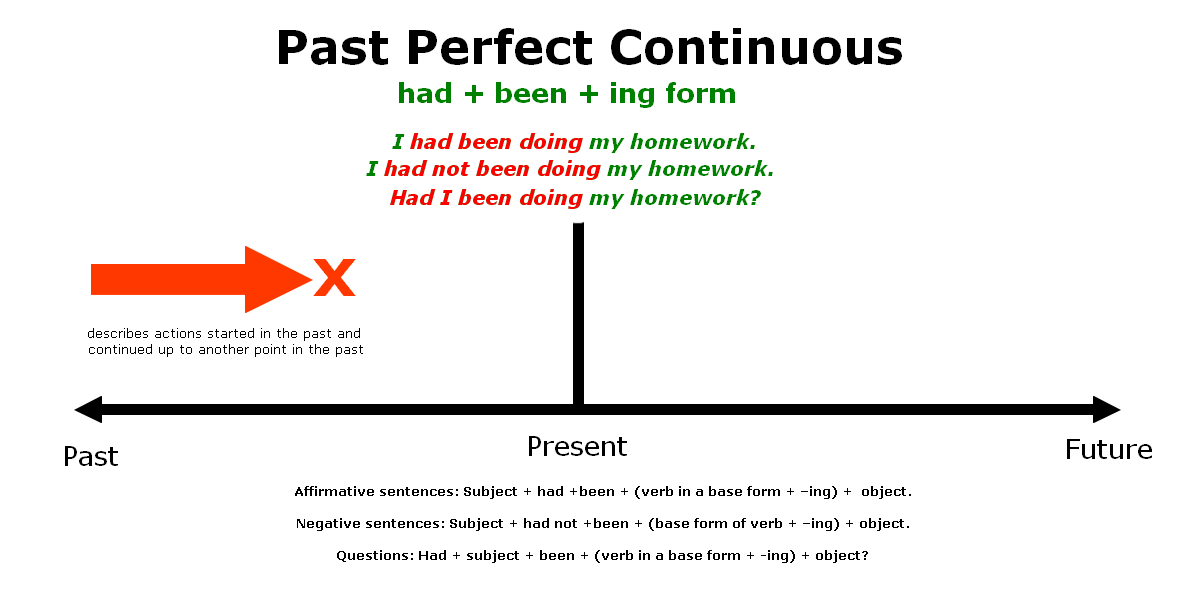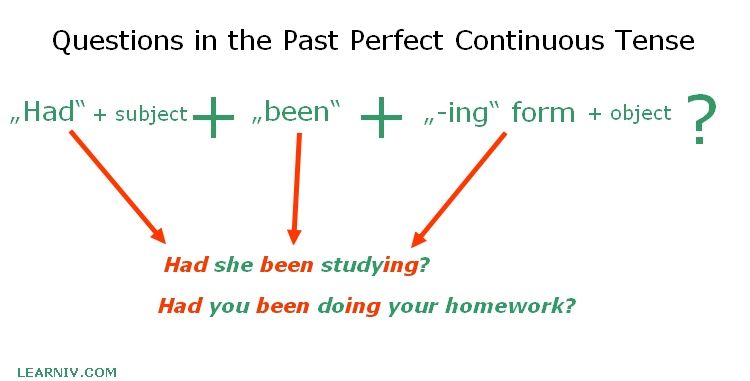The past perfect continuous tense (sometimes referred to as the past perfect progressive tense) is specific type of tense in English. It is easy to learn but harder to use. As we already know, the past perfect continuous also describes events that „passed in the past“ – just like the past perfect tense.
The only difference is that the past perfect continuous describes events that started, lasted but also ended at some point in the past.
To construct sentences in the past perfect continuous, we need to use the auxiliary verb „had“ with the auxiliary verb „been“ and a main verb with the suffix –ing.
Look at past perfect continuous tense examples.
When do we use the past perfect tense?
Referring to a past situation
We use the past perfect continuous to talk about an ongoing action that ended before another action that happened in the past.
Example:
- She had been looking for a nanny for 3 months when she found Mrs. Kelly.
She had been looking for Mrs. Kelly for a long period of time and stopped looking for her when she found her. Logically, she had to end looking for a nanny when she found Mrs. Kelly. This is a reason to use the past perfect continuous.
Focusing on an action in the past
As with all continuous tenses, we use the past perfect continuous to focus on an action itself. It doesn’t matter if the action was completed or not, all that matters is that something happened. We focus on the effect on a subject rather than on the completion of an event.
Example:
- They had been unloading the furniture from the trunk when the rain started.
We do not know if the unloading was completed or not – it is not even important. The main thing here is focusing on their action.
Events that lasted for a longer period in the past
We use the past perfect continuous tense to talk about events in the past that lasted for a long period of time. We can also specify how long an event had lasted.
Example:
- He was tired because he had been driving for 12 hours without a break.
- We had been walking on the beach for many hours when it stopped raining.
- How long had you been waiting before she finally came?
Some plot has led to some state
This tense is also used to describe when some action led to some other action/situation or feeling. We do not specify when the event happened, but we know that it was caused by some other event in the past.
Example:
- He was tired because he had been working all night.
- Her eyes were red. Had she been crying again?
- Jamie decided to see a doctor because he had been feeling tired all the time.
Construction of the past perfect continuous tense
To construct sentences in this tense we first need to memorize some rules. We need to know how to use this tense correctly and when the right opportunity to use it is. We must also know how to construct these types of sentences – it is not as hard as it might look like.
Verb „had“
We need to conjugate the auxiliary verb „have“ to its past simple form „had“. This verb is really important for constructing any sentence in the past perfect continuous.
Verb „been“
We also have to conjugate the auxiliary verb „be“ to its past participle form „been“. This is really important to correctly construct sentences.
Main verb
The last thing we have to know is that every main verb has to end with the suffix – ing (ing form of the verb). This applies to all continuous tenses. Always use the verb + ing.
Combining all of the above, we get the structure of the past perfect continuous tense:
Subject + had + been + verb (-ing) + object.
We always use the same sentence structure and do not differentiate between singular or plural subjects or persons.
Example:
- I had been working.
- She had been working.
- We had been working.
- They had been working.
Affirmative sentences
The affirmative past perfect continuous is constructed using the 2nd form of the verb „have“, the 3rd form of verb „to be“ and a verb in basic form with the suffix – ing.
Together, the sentence will look like:
Subject + had + been + verb (-ing) + object.
In contrast to the past simple tense, we do not differentiate between the number or type of subject (singular/plural). All the subjects are used in combination with „had + been + verb -ing“.
Even though this tense seems to be harder than the past perfect tense, it is actually easier because we do not have to memorize English irregular verbs. The only thing we have to learn are the verbs „had“ and „been“. The rest of the sentence is pretty easy to construct.
Example:
- Jamie was really tired. She had been running.
- She had been working for this company for 5 years before I came here too.
- I had been walking 4 miles per day before I broke my leg.
Negative sentences
To construct a negative sentence in the past perfect continuous tense it is necessary to use the auxiliary verb „had not“, or its short-form „hadn’t“.
The sentence will look like:
Subject + had not/hadn’t + been + verb + (-ing) + object.
Example:
- My car broke down. I was not surprised; it had not been doing well for a while.
- We had not been talking for many years until now.
- She had not been drinking alcohol for 5 months either.
Questions
Questions in the past perfect continuous are really easy to construct. The only thing we have to change is the word order by putting the verb „had“ at the beginning of the sentence while the rest of the sentence is pretty similar in form to affirmative sentences.
The sentence will look like:
Had + subject + been + main verb (-ing) + object.
Examples:
- Had you been waiting for her for a long time?
- Had they been sleeping until the afternoon last summer?
- Had those children been playing?
Past perfect vs past perfect continuous
Both tenses are pretty similar in meaning as they both describe some event in the past that happened before another action in the past. The only difference is that:
Past perfect tense
This tense describes events that happened and already ended in the past.
Past perfect continuous tense
This tense describes events that happened in the past, but we do not care too much if they were finished or not. We emphasize only the action and its course.
When do we not use the past perfect continuous?
There are a few instances when we cannot use the past perfect continuous. One of these is when we want to describe a situation using stative verbs.
Stative verbs
The only verbs we cannot use with the suffix –ing are stative verbs, which describe certain states such as feelings. These verbs do not describe actions or activities.
Some examples of stative verbs are know, like, need, want, cost, love, hate, etc. We cannot use these verbs with the suffix –ing, or use them with any other tense other than the past perfect tense.
Example:
Correct: It was like they’d known each other for 10 years.
Wrong: It was like they had been knowing each other for 10 years.
Contraction of the past perfect continuous
When we use the past perfect continuous tense in speech, we try very often to shorten the subject with the first verb „had“. We do the same in informal writing.
Example:
- I had been writing… –> I’d been writing…
- They had been living… –> They’d been living…
- He had been drinking beer the whole day… –> He’d been drinking beer the whole day…




